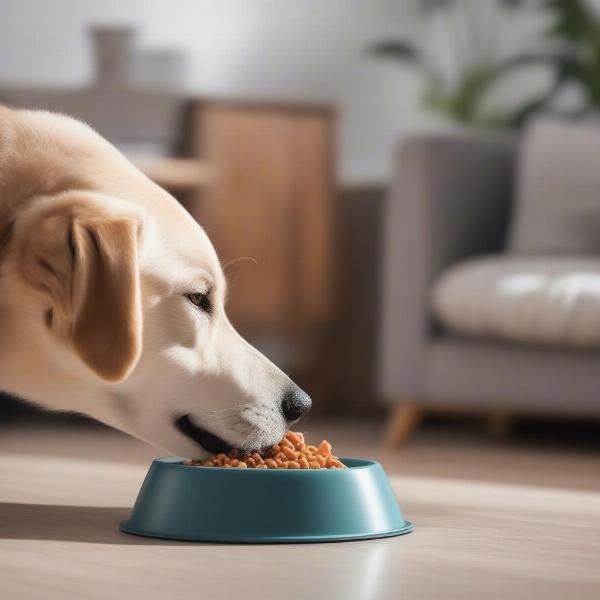A dog bowl for slower eating, also known as a slow feeder bowl, can be a game-changer for dogs who inhale their food. This simple switch can prevent a range of health issues, from choking and vomiting to bloat, a life-threatening condition. Choosing the right slow feeder bowl depends on your dog’s breed, size, eating habits, and the type of food they consume. Let’s explore how to find the perfect slow feeder to promote healthier eating habits for your furry friend.
Why a Slow Feeder Bowl is Important
Fast eating in dogs can lead to several problems. Gulping down air with food can cause vomiting and discomfort. More seriously, it increases the risk of gastric dilatation-volvulus (GDV), or bloat, a dangerous condition where the stomach twists, cutting off blood supply. Slow feeder bowls help regulate food intake, reducing these risks and promoting better digestion.
What are the benefits of using a slow feeder bowl? Slower eating allows for better digestion as saliva can mix properly with the food. It also provides mental stimulation for your dog, turning mealtime into a more engaging activity.
Types of Slow Feeders: Finding the Perfect Fit
Slow feeder bowls come in various designs. Some feature raised obstacles or maze-like patterns, forcing the dog to maneuver their food around. Others have individual compartments, distributing the food into smaller portions.
 A dog eating from a slow feeder bowl
A dog eating from a slow feeder bowl
Which type of slow feeder is best for your dog? The best slow feeder bowl depends on your individual dog’s needs. Consider their breed, size, and eating habits. For example, a flat-faced breed might benefit from a shallower bowl.
Choosing the Right Material and Size
Slow feeders are available in various materials, from plastic and ceramic to stainless steel. Stainless steel is often preferred for its durability and hygiene, being easy to clean and resistant to bacteria.
What size slow feeder bowl do I need? The size of the bowl should correspond to your dog’s food portion and overall size. A bowl that’s too small can frustrate your dog, while one that’s too large might defeat the purpose of slowing them down.
Introducing the Slow Feeder to Your Dog
Introducing a slow feeder should be a gradual process. Start by mixing a small amount of food in the slow feeder with their regular bowl. Gradually increase the proportion of food in the slow feeder until they are comfortable using it exclusively.
“Introducing a slow feeder gradually is key,” says Dr. Emily Carter, a veterinary nutritionist. “It allows your dog to adjust to the new eating style and prevents frustration.”
Cleaning and Maintenance
Regular cleaning is essential for any dog bowl, especially slow feeders with intricate designs. Wash the bowl thoroughly with soap and water after each use to prevent bacterial growth and maintain hygiene.
How often should I clean my dog’s slow feeder? Just like regular dog bowls, slow feeders should be cleaned daily. This prevents the build-up of bacteria and keeps your dog’s eating area hygienic.
Conclusion
A dog bowl for slower eating is a valuable investment for your dog’s health and wellbeing. It helps prevent choking, vomiting, and bloat, promoting better digestion and a more enjoyable mealtime. By considering factors such as your dog’s breed, size, and eating habits, you can choose the perfect slow feeder bowl to support their long-term health.
FAQ
- Why is my dog eating so fast? Several factors can contribute to fast eating, including competition with other pets, past experiences with food scarcity, or simply an enthusiastic personality.
- Can puppies use slow feeder bowls? Yes, slow feeders can be beneficial for puppies too, helping them develop healthy eating habits from a young age.
- What if my dog doesn’t like the slow feeder? Try different designs or materials until you find one that suits your dog. Gradual introduction is also crucial for acceptance.
- Are slow feeders suitable for all breeds? While generally beneficial, some breeds with flat faces might struggle with certain designs. Consult your veterinarian for personalized recommendations.
- How can I tell if the slow feeder is working? You should observe a noticeable decrease in the speed at which your dog eats, and less gulping of air.
- Can I use a slow feeder for wet food? Yes, some slow feeders are designed to accommodate both wet and dry food.
- Are there any disadvantages to using a slow feeder? Some dogs may become frustrated initially. Choose a design appropriate for your dog’s size and breed to minimize this.
ILM Dog is a leading international website dedicated to providing expert advice on dog care and wellbeing. We offer comprehensive information on various aspects of dog ownership, from breed selection and health care to training, nutrition, and grooming. We’re passionate about helping dog owners provide the best possible care for their furry companions. For expert advice or to learn more about our services, contact us at [email protected] or call us at +44 20-3965-8624. ILM Dog is your one-stop resource for all things dog-related!